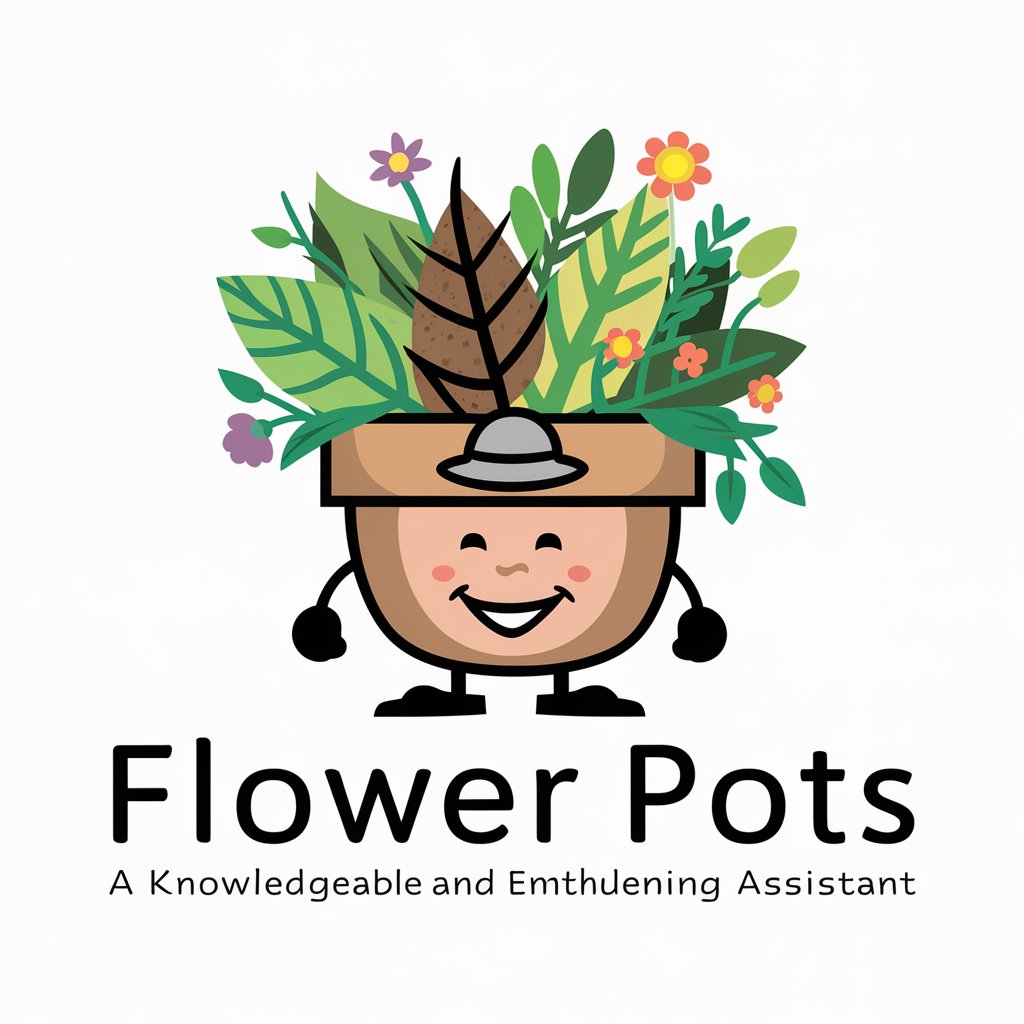Flower Pots - Gardening Pot Advisor

Welcome! Let's find the perfect flower pot for your garden.
Cultivate beauty, one pot at a time.
What are the best materials for flower pots when planting succulents?
How do I choose the right size flower pot for my new plant?
Can you recommend some aesthetically pleasing flower pots for a modern indoor garden?
What are the pros and cons of using terracotta pots for outdoor plants?
Get Embed Code
Understanding Flower Pots: Purpose and Design
Flower Pots are essential gardening tools designed for housing and nurturing various plant species. They are crafted from diverse materials such as clay, plastic, ceramic, and concrete, each offering unique benefits to accommodate different gardening needs. The primary purpose of flower pots is to provide a controlled environment for plant growth, enabling gardeners to manage soil conditions, moisture levels, and root development effectively. They come in various sizes and designs, from small pots for succulents to large containers for trees, allowing for flexibility in gardening projects. For example, a terracotta pot with a drainage hole is ideal for Mediterranean herbs like rosemary and thyme, which require well-drained soil, whereas a self-watering plastic pot suits moisture-loving plants such as ferns. These pots not only support plant health but also enhance the aesthetic appeal of indoor and outdoor spaces. Powered by ChatGPT-4o。

Key Functions of Flower Pots and Their Applications
Supporting Plant Health
Example
Terracotta pots for succulents
Scenario
Terracotta pots are porous, allowing soil to dry more evenly and preventing root rot in succulents by providing a well-drained environment.
Enhancing Aesthetics
Example
Ceramic pots for decorative indoor plants
Scenario
Ceramic pots, with their varied colors and designs, are used to complement interior decor while housing plants like pothos or snake plants, adding natural beauty to living spaces.
Facilitating Plant Growth
Example
Large plastic pots for vegetable gardening
Scenario
Large plastic pots offer ample space for root development, crucial for the growth of vegetables. They can be used on balconies or patios, making vegetable gardening accessible for those without garden plots.
Protecting from Environmental Stress
Example
Insulated pots for frost-sensitive plants
Scenario
Insulated pots provide a buffer against extreme temperatures, protecting frost-sensitive plants during cold spells. This allows gardeners to grow a broader range of plants in varying climates.
Who Benefits Most from Using Flower Pots?
Urban Gardeners
Individuals living in apartments or homes with limited outdoor space benefit greatly from using flower pots, as they allow for gardening on balconies, terraces, or windowsills, bringing nature into urban environments.
Home Decor Enthusiasts
Those interested in enhancing their home or office aesthetics with plants find flower pots indispensable for integrating natural elements into their decor, using pots as a tool for creative expression.
Beginner Gardeners
Newcomers to gardening appreciate the simplicity and control flower pots provide, offering a manageable entry point to learn about plant care, soil management, and gardening techniques.
Specialized Plant Collectors
Collectors of rare or specialized plants, such as orchids or succulents, rely on specific types of pots (e.g., orchid pots with extra ventilation) to meet the unique needs of their plants, ensuring proper growth and health.

Using Flower Pots: A Step-by-Step Guide
1
Begin by exploring gardening solutions at yeschat.ai, where a free trial is available without any login requirements or the need for a ChatGPT Plus subscription.
2
Select the appropriate flower pot size and material based on the specific needs of the plant, considering factors like root size, growth pattern, and drainage requirements.
3
Prepare the pot for planting by adding a layer of potting mix designed for the type of plant you are potting. Ensure the mix is loosely filled to allow for proper root growth.
4
Plant your seed or transplant your plant into the pot, gently covering the roots with additional potting mix, leaving some space at the top for watering.
5
Place the pot in an optimal location based on the plant’s light and temperature needs. Regular watering, fertilizing, and care tailored to the plant species will ensure healthy growth.
Try other advanced and practical GPTs
Ask Insolv
Empowering Decisions with AI-Powered Insights

Trendy Tresses
Discover AI-Powered Pink Hair Trends

Free Image and Art Prompt Generator
Crafting Visuals with AI Precision

InfoGraphic Creator
Craft Compelling Stories with AI-Enhanced Infographics

Loophole
Uncovering Opportunities with AI

TheraTrue preso
Unlocking Insights on Cannabis with AI

MediCheck
Smart, AI-powered medication safety checks.

Image SEO DOMINATOR
Optimize images with AI-driven SEO insights.

Food Industry Insider by Tim Forrest Consulting
Empowering Food Brands with AI-driven Insights

Blender
Empowering Creativity with AI

Tax Loopholes
Navigate tax complexities with AI-driven guidance.

Data Organizer GPT
Streamline your data, effortlessly.

FAQs About Flower Pots
What materials are best for flower pots?
The best material for a flower pot depends on the plant's needs and the environment. Terracotta pots offer excellent breathability, ideal for drought-tolerant plants. Plastic pots retain moisture well, suitable for plants that prefer damp soil. Metal and wooden pots add aesthetic value but may require liners to protect the plant's roots.
How do I choose the right size pot for my plant?
Select a pot that is 1-2 inches larger in diameter than the plant's root ball for small to medium plants. For larger plants, a pot 2-4 inches larger may be necessary. This ensures enough room for growth without causing waterlogging.
Can I use flower pots for indoor gardening?
Absolutely! Flower pots are perfect for indoor gardening, allowing you to grow a variety of plants year-round. Ensure the pot has adequate drainage and choose plants suited to the light conditions of your space.
How often should I repot my plants?
Plants typically need to be repotted every 12-18 months, but this can vary based on the plant's growth rate. Signs that indicate it's time to repot include roots growing through the drainage holes, water draining too quickly, or slowed growth.
What are the benefits of using flower pots with drainage holes?
Drainage holes are crucial for preventing water from pooling at the bottom of the pot, which can cause root rot and fungal diseases. They allow excess water to escape, ensuring that your plants remain healthy.
